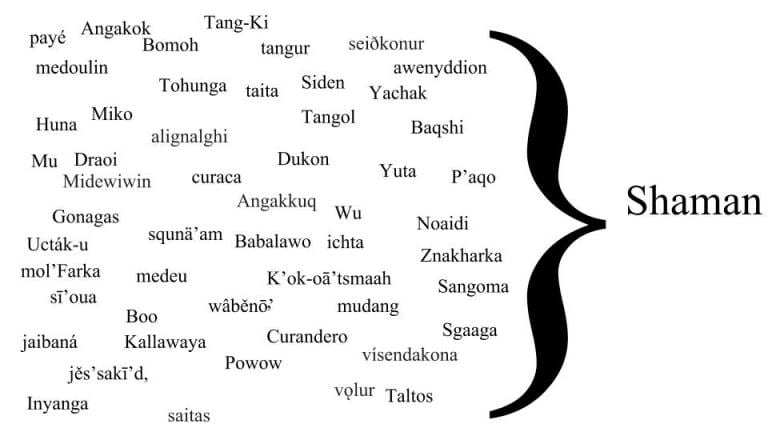Since time immemorial, across every culture on earth, people have turned to the inner worlds for healing, strength and clarity. The term “shamanic” as I use it refers to this universal phenomenon, not tied to a particular culture or tradition—a spiritual rather than a psychological system, based on the ability to step outside the modes of conventional thinking to authentically access altered states and hold space for healing to occur.
In this sense, pretty much every new age practitioner is doing shamanic work, whether they are a channel, a healer, a medium, a psychic, a card reader, a life coach, or anything else. This applies to most artists as well: musicians, poets, dancers, painters, and so on. And it applies to all forms of ritual and ceremony, prayer, invocation, mantras, and deity visualizations, whether Christian, Wiccan, Sufi, Hindu or Tibetan. They are all connecting to other levels of reality to bring back something of value. This is the essence of shamanism.
Where does the term “shaman” come from?
The term shaman or šaman comes to us from the Manchu-Tungus people of Siberia, and may have originated from the Evenki word šamán.
Although for many of us the term shaman suggests a medicine person of South American or Native American origin, this is technically inaccurate. The chart below, courtesy of Julia Penelope’s excellent article on 6 Reasons To Stop Using The Word Shaman, illustrates all the words she could find in 15 minutes from different languages that are frequently re-labeled under the aegis of shaman. In Latin America, for instance, the practice of spiritual healing is called curanderismo and the term for a traditional healer is curandero or curandera.

Why then do so many people associate the term “shaman” with South or Native American cultural practices?
The term “shaman” in Western circles was popularized by the anthropologists Mircea Eliade (Shamanism: Archaic techniques of Ecstasy, 1964), Michael Harner (The Way of the Shaman, 1980) , and Carlos Castaneda (The Teachings of Don Juan: A Yaqui Way of Knowledge, 1968), with the wholly well-meaning intent to replace the term witch doctor or sorcerer with a term less loaded with a negative or demeaning connotation. These were the first Western academics to take a serious interest in indigenous mystical practices.
Both Michael Harner and Carlos Castaneda lived and studied with the Shuar (Jívaro) of Ecuador, and Harner went on to found the The Foundation for Shamanic Studies that offers a 3-year certification as a shamanic practitioner. A majority of modern practitioners of shamanic healing methods are connected to this school, hence the assumed connection of the term shaman with South America.
Mircea Eliade, who was first to defend the use of this term in a broader context, defines a shaman as follows:
he is believed to cure, like all doctors, and to perform miracles of the fakir type, like all magicians […] But beyond this, he is a psychopomp, and he may also be a priest, mystic, and poet.
If we define shamanism this way, Eliade claims, we find that the term covers a collection of phenomena that share a common and unique structure and history across the cultural spectrum.
What is core shamanism vs cultural shamanism vs neoshamanism?
In the spirit of Eliade’s views, Michael Harner coined the term core shamanism, in acknowledgement of the near universal phenomenon across numerous cultures, traditions, and religions, of healers, mystics, prophets, priests, musicians, artists, poets, etc. who have accessed altered states of consciousness, through a variety of techniques, in order to interact with the Spirit world and receive its gifts. Harner’s Foundation for Shamanic Studies aims to restore time-honored techniques to the Western world, to enable those of us raised outside of cultures that have preserved these practices to be able reconnect with our own internal spiritual resources. Hence, core shamanism focuses on universal techniques, most specifically drumming, and not on any specific cultural context in which they may be practiced. When I refer to my work as “shamanic” I am referring to this use of the term.
Cultural shamanism, by contrast, refers to the traditional ways of individual cultures. There is much to learn and unpack on the why and how of these masters of reality, who are as varied as they are alike. Nevertheless, those practicing cultural shamanism are often quick to criticize, with good reason, practitioners of core shamanism or neoshamanism who don traditional dress, and make use of sacred objects, without the proper initiations, and without a full understanding of their meaning and the depth of the culture they come from. In general, it is a good rule of thumb to approach the tradition in the way of the tradition, lest we wake a sleeping giant — in my view, the sacred should always be approached with the utmost respect! I am also personally extremely sensitive to implied or intended cultural appropriation, which is an important topic in the world today, and I am currently treading lightly, trying to find my way through this maze.
Neoshamanism refers to the immense popularity of drumming and entheogens (such as ayahuasca and peyote) among experience seekers and new age practitioners, along with other eclectic methods of achieving ecstatic trance states, healing, or visions. This can include a grab bag of necessarily watered-down practices (including vision quests, sweat lodges, ecstatic dancing, breathing techniques, fasting) catering to the spiritual tourist, that generally don’t have the power of when they are practiced within the full cultural context. For the cultural practitioner, these practices are frequently found to be offensive, the major criticisms being that neoshamanism 1) plays down the real dangers of interacting with the spirit world without the proper protections of an initiatory lineage and guidance of a master, 2) features a denial of the hardship of shamanic initiation and preparation, and the necessity of deep study to develop a keen understanding of the nature of the other worlds, and 3) most importantly, diverges from both cultural and core shamanism in that it is often focused on self gratification, whereas the true path of the shaman is that of service, to be a bridge between the worlds, going where most mortals fear to tread.
Are you a shaman?
A shaman, in the true sense, is a master healer, in the same vein as a guru or a saint. A self-professed shaman rarely is, and it is well understood that the highest spiritual initiates who walk between the worlds often do their work in secret and maintain a low profile.
Just as a guru or a saint, a shaman is recognized rather than certified. Hence, for those of us using the term in a descriptive sense for a particular style of healing, the correct term is shamanic practitioner.
The modern shamanic practitioner is a synthesis of knowledge derived across lifetimes and cultures. Ultimately, only one thing defines a shaman: whether you are called by Spirit or not. There is work to be done in this world, and when Spirit knocks, we answer.
References
- Shamanism in Siberia https://en.wikipedia.org/wiki/Shamanism_in_Siberia
- 6 Reasons To Stop Using the Word “Shaman” https://www.patheos.com/blogs/thewanderingwitch/2019/03/6-reasons-you-should-stop-using-the-word-shaman/
- Ancient Man Is In Us Still https://www.nytimes.com/1964/07/12/archives/ancient-man-is-in-us-still-shamanism-archaic-techniques-of-ecstasy.html
- Definition of Core Shamanism https://www.shamanism.org/workshops/coreshamanism.html
- Foundation for Shamanic Studies https://www.shamanism.org/fssinfo/index.html
- Masters of Reality https://aeon.co/essays/why-did-shamanism-evolve-in-societies-all-around-the-globe
- The Withdrawn Order from W. E. Butler’s Lords of the Light
- What is the Shamanic Illness http://www.settingsunwellness.com/blog/2016/3/18/6f164jnxntdx7gnnwx66uanmtfnlgc
- Shamanism in the Modern World https://www.shamanscave.com/contemporary-shamanism/shamanism-in-modern-world
- Who Is The Modern Shaman? https://www.theshamanspath.org/single-post/2019/02/06/Who-is-the-Modern-Shaman-A-Global-Citizen
- 10 Signs You’re a Shaman & Don’t Know It https://www.thesacredscience.com/10-signs-youre-a-shaman-dont-know-it/

